Space Relationship of India with Neighbouring Countries | Geography Optional for UPSC PDF Download
| Table of contents |

|
| Indian Geographical Extent and Frontiers |

|
| Size and Extent – |

|
| Coastline of India |

|
| Eastern Coastal Plains of India |

|
| Standard Time (Time Zone) |

|
Indian Geographical Extent and Frontiers
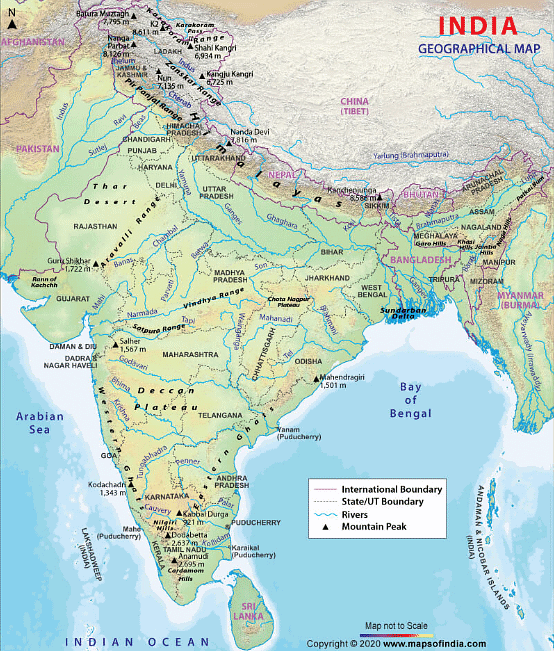 India Physical
India Physical
India is an expansive country situated entirely in the northern hemisphere, particularly in the south-central region of the Asian continent. Its mainland lies between latitudes 8°4'N and 37°6'N, and longitudes 68°7'E and 97°25'E, making it the 7th largest country in the world. India's unique geographical identity is distinguished by its separation from the rest of Asia through mountains and the sea, creating a distinct geographical entity.
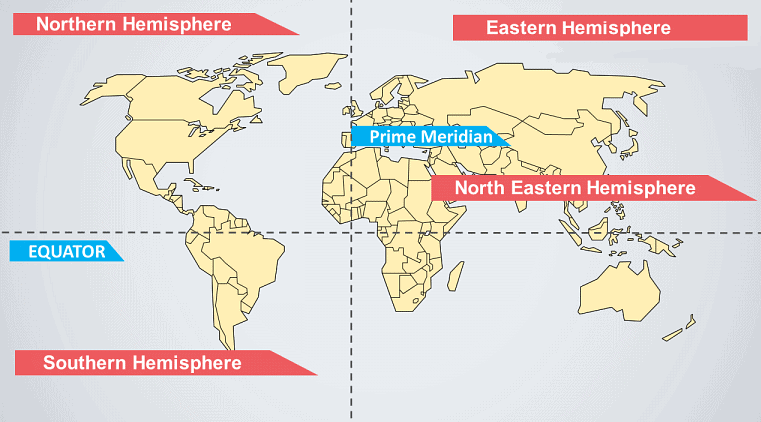 India in Northern Hemisphere
India in Northern Hemisphere
India has a land border that stretches approximately 15,200 km and a coastline that spans 7,516.6 km, encompassing the mainland as well as the Andaman and Nicobar and Lakshadweep islands. The country is surrounded by young fold mountains in the northwest, north, and northeast regions. Moving south of around 22° north latitude, India's landmass narrows and extends towards the Indian Ocean, separating it into the Arabian Sea to the west and the Bay of Bengal to the east. The mainland's latitudinal and longitudinal range is roughly 30°, but the east-west distance seems shorter than the north-south distance, despite this measurement.

India spans a vast longitudinal range, with a time difference of two hours between its westernmost state, Gujarat, and its easternmost state, Arunachal Pradesh. To maintain consistency, the entire country follows a standard time based on the Standard Meridian of India, which passes through Mirzapur in Uttar Pradesh at 82°30’E longitude.
The country's latitudinal extent also affects the duration of daylight and nighttime, with variations experienced as one travels from the south to the north. Additionally, the Tropic of Cancer bisects India, crossing through eight states, including Gujarat, Rajasthan, Madhya Pradesh, Chhattisgarh, Jharkhand, West Bengal, Tripura, and Mizoram. This geographical feature further contributes to the diverse climate and daylight patterns observed across the nation.
 Tropic of Cancer
Tropic of Cancer
Size and Extent –
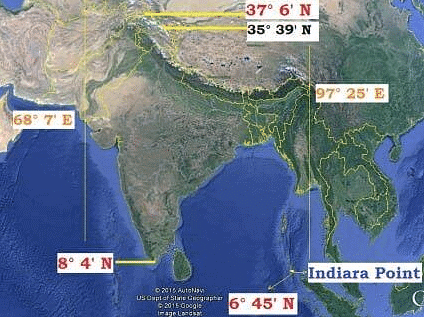 Longitudinal and latitudinal extent
Longitudinal and latitudinal extent

 Points of India
Points of India
- The southernmost point of India, known as Pygmalion Point or Indira Point, is situated at a latitude of 6° 45′ N. The country stretches from Indira Col in Kashmir to Kanniyakumari, with a north-south distance of 3,214 km, and an east-west width of 2,933 km, extending from the Rann of Kachchh to Arunachal Pradesh. India ranks as the seventh-largest country in the world, covering an area of 32,87,263 sq km, which represents approximately 2.4% of the world's total surface area.
- The Tropic of Cancer divides India into two latitudinal halves, with the northern section being nearly twice the size of the southern section. South of the 22° north latitude, India narrows for over 800 km and extends into the Indian Ocean as a peninsula.

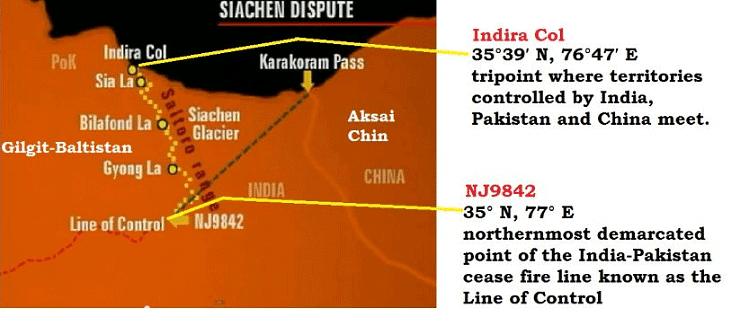 Siachen Glacier
Siachen Glacier
Coastline of India
India is a country that is surrounded by the sea on three of its sides. The coastal plains in India are along the west and east of the country. Extending up to 7516.6 km, the coastal plains in India are of two types:
- Eastern Coastal Plains of India
- Western Coastal Plains of India
Eastern Coastal Plains of India
The Eastern Coastal Plains of India span from West Bengal in the north to Tamil Nadu in the south, passing through Andhra Pradesh and Odisha. These plains are home to the fertile deltas of the Mahanadi, Krishna, Godavari, and Cauveri rivers. The Krishna River delta, in particular, is known as the 'Granary of South India' due to its agricultural productivity. The eastern coastline can be divided into three distinct regions:- Utkal Coast: Located between Chilika Lake and Kolleru Lake, this coastal area is much wider than the Western Coastal Plains and receives heavy rainfall. Major crops cultivated here include rice, coconut, and banana.
- Andhra Coast: This coastal region stretches between Kolleru Lake and Pulicat Lake and serves as a basin for the Krishna and Godavari rivers.
- Coromandel Coast: Extending from Pulicat Lake to Kanyakumari in Tamil Nadu, the Coromandel Coast remains dry during the summer and receives rainfall in winter due to the northeast monsoons. Important geographical features of the east coast include Chilka Lake and Pulicat Lake (lagoon).
The Western Coastal Plains of India stretch from Kerala in the south to Gujarat in the north, passing through Karnataka, Goa, and Maharashtra. These plains span 1500 km from north to south and have a width ranging from 10 to 25 km. The West Continental Shelf is at its widest off the coast of Bombay, which is rich in oil. The Malabar Coast features stunning lagoons, making it a popular tourist destination. The western coast is narrower than the eastern coast and can be divided into four categories:
- Kachchh and Kathiawar Coast: Kachchh, which was formerly a gulf, was formed by the deposition of silt by the Indus River. The area is covered with shallow water during monsoons and is divided into the Great Rann in the north and Little Rann in the east. Kathiawar is situated to the south of Kachchh.
- Konkan Coast: This coastal area stretches from Daman in the north to Goa in the south. Rice and cashew crops are significant in this region.
- Kanada Coast: Located between Marmagaon and Mangalore, this coastal region is rich in iron deposits.
- Malabar Coast: Spanning from Mangalore to Kanyakumari, the Malabar Coast is relatively broad and features lagoons running parallel to the coast in southern Kerala.
Konkan coast = Maharashtra coast and Goa coast;
Malabar Coast = Kerala and Karnataka coast.
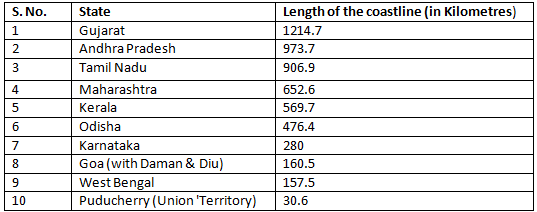 Channels at Islands
Channels at Islands
Standard Time (Time Zone)
- Every location on Earth is defined by its distance east or west from the prime meridian, which is the longitudinal line at 0 degrees longitude that passes through Greenwich, London, United Kingdom. This prime meridian is also the reference point for Coordinated Universal Time (UTC), with each hour being equivalent to 15 degrees of longitude.
- For instance, a location at 150 degrees west longitude (150 W) would have a time that is 10 hours behind UTC, calculated by dividing 150 degrees by 15 degrees, resulting in UTC-10.
- In the case of India, the reference point for Indian Standard Time (IST) is at 82 degrees 30 minutes east longitude. This means that India is ahead of UTC by 5 hours and 30 minutes. The Indian Standard Meridian, which serves as the reference line for IST, passes through the states of Uttar Pradesh, Madhya Pradesh, Chhattisgarh, Odisha, and Andhra Pradesh.
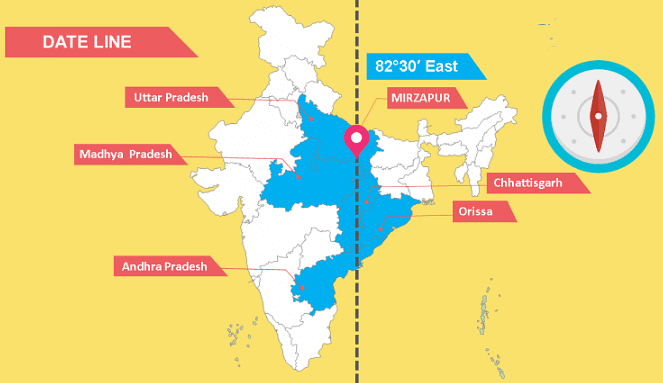 IST
IST
India, Tropical or Temperate Country?
- The temperate part (north of Tropic of Cancer) is twice the area of tropical part.
- But India has always been treated as a tropical country for two different reasons – physical and cultural.
Physical Geographical Reasons
- The Himalayas serve as a natural barrier that separates India from the rest of Asia, resulting in distinct geographical features. This mountain range also blocks temperate air masses, causing the country's climate to be predominantly influenced by tropical monsoons.
- Despite some areas in North India experiencing winter night temperatures similar to those in temperate regions, the clear skies and strong sunlight during the day raise temperatures to a tropical level. Therefore, the area south of the Himalayas can be considered essentially tropical from a climatic perspective.
Cultural Geographical Reasons
- Settlements, diseases, agricultural and primary economic activities are all tropical in nature.
India’s Frontiers
Reference: Ministry Of Home Affairs
- India shares a land border of 15,106.7 km with 92 districts across 17 states, and has a coastline of 7,516.6 km, which includes a 6,100 km mainland coastline and the coastline of 1,197 Indian islands, touching 13 states and union territories.
- All states in the country, except for Madhya Pradesh, Chhattisgarh, Jharkhand, Delhi, Haryana, and Telangana, share either an international border or a coastline, making them crucial for border management.
- The longest international border India shares is with Bangladesh, while its shortest border is with Afghanistan.
- The length of India’s land borders with neighboring countries is as under:
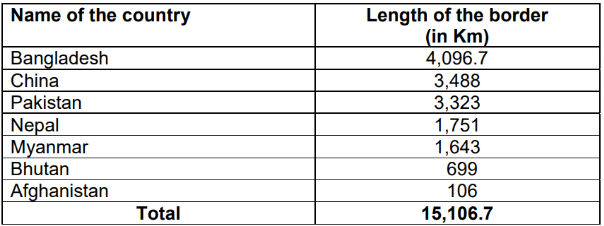 Ministry of Home Affairs
Ministry of Home Affairs
Ministry of Home Affairs
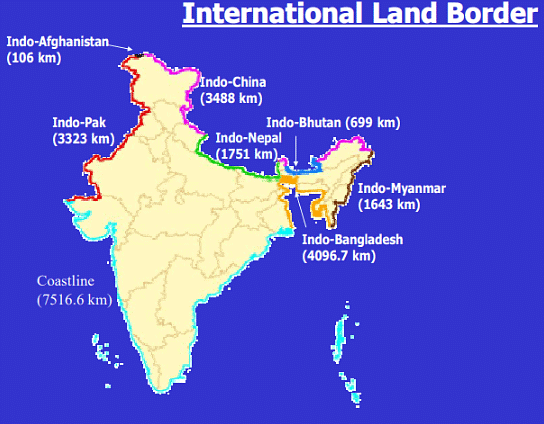 International Borders
International Borders
Border with China
- The border between India and China is the second longest border for India, surpassed only by its border with Bangladesh.
- The Indian states that share this border with China include Jammu and Kashmir, Himachal Pradesh, Uttarakhand, Sikkim, and Arunachal Pradesh.
- The Sino-Indian border can be categorized into three main sectors: the Western sector, the Middle sector, and the Eastern sector.
The Western Sector
- The Western Sector is a boundary region that divides the union territory of Jammu and Kashmir and Ladakh from the Sinkiang (Xinjiang) province of China. The demarcation of this boundary has largely been influenced by the British policy towards Jammu and Kashmir.
- China lays claim to several areas within this sector, including the Aksai Chin district, the Changmo valley, Pangong Tso, and the Sponggar Tso region in northeastern Ladakh. Additionally, China claims a strip of land stretching approximately 5,000 square kilometers along the entire length of eastern Ladakh. Moreover, China claims a portion of the Huza-Gilgit area in North Kashmir, which was ceded to it by Pakistan in 1963.
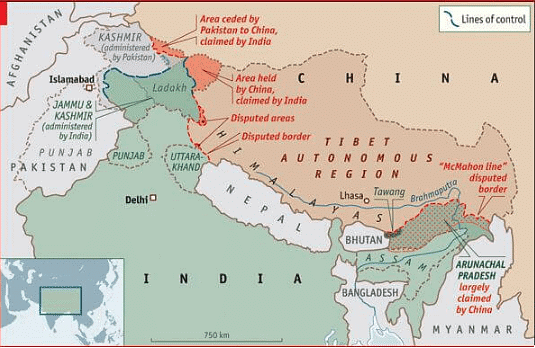 Indo-China dispute
Indo-China dispute
The Middle Sector
- Two Indian states of Himachal Pradesh and Uttarakhand touch this border.
The Eastern Sector
- The 1,140 km long boundary between India and China runs from the eastern limit of Bhutan to a point near Diphu pass (Talu Pass) at the trijunction of India, Tibet, and Myanmar.
- This line is usually referred to as the Mc Mahon Line after Sir Henry Mc Mahon, then foreign secretary of British India, who negotiated the boundary agreement between Great Britain and Tibet at Shimla accord in 1913-14.
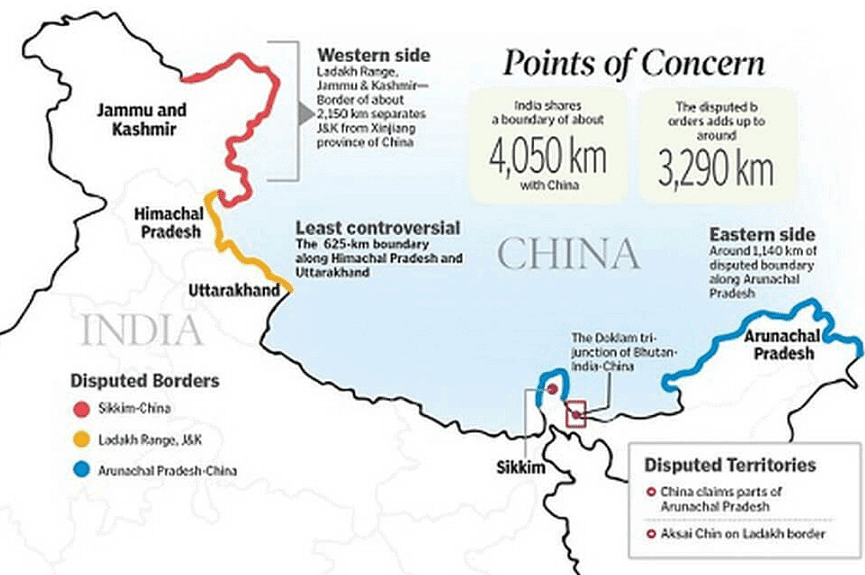 LAC
LAC
Disputed Territories
Western Sector
- In the western sector, India and China share a border that stretches approximately 2152 km in length. This border lies between the Union Territory of Ladakh, which was formerly part of the state of Jammu and Kashmir in India, and the Xinjiang Province in China. A significant territorial dispute exists between the two countries over the Aksai Chin region. India argues that Aksai Chin belongs to the former state of Kashmir, while China asserts it is part of their Xinjiang Province.
- The origin of this dispute can be traced back to the British Empire's failure to establish a clear and legal border between China and its Indian colony. During British rule in India, two potential borders between India and China were proposed: Johnson's Line and McDonald Line.
- Johnson's Line, proposed in 1865, placed Aksai Chin within the territory of the former Jammu and Kashmir (now Ladakh), implying it was under Indian control. In contrast, the McDonald Line, proposed in 1893, allocated Aksai Chin to China. Consequently, India supports the Johnson Line as the accurate, legitimate border with China, while China favors the McDonald Line as the correct boundary.
- Currently, the Line of Actual Control (LAC) demarcates the division between the Indian-controlled Ladakh and the disputed region of Aksai Chin. The LAC coincides with the border claimed by China in the Aksai Chin area.
Middle Sector
- In this sector, India shares about 625 km long boundary with China which runs along the watershed from Ladakh to Nepal.
- Himachal Pradesh and Uttarakhand touch this border with Tibet (China) in this sector. Both sides do not have much disagreement over the border in this area.
Eastern Sector
- In the Eastern Sector, India shares a 1,140 km long border with China that extends from the eastern edge of Bhutan to a point near the Talu Pass, where the borders of Tibet, India, and Myanmar intersect. This boundary is known as the McMahon Line.
- However, China views the McMahon Line as unlawful and unacceptable, arguing that the Tibetan representatives who signed the 1914 Shimla Convention, which established the McMahon Line on the map, did not have the authority to do so.
The India-Nepal Boundary
- The India-Nepal boundary stretches for approximately 1,751 kilometers (1,088 miles) and is one of the longest open international borders in the world. The border is unique because of the close cultural, historical, and economic ties between the two countries, as well as the open border policy that allows for the free movement of people across the border.
- The border is marked by several rivers, such as the Mahakali River in the west, which separates Uttarakhand in India from the Sudurpashchim Pradesh in Nepal, and the Mechi River in the east, which separates West Bengal in India from Province No. 1 in Nepal. In between these rivers, the border is demarcated by boundary pillars and is largely based on the watershed principle, which means that it follows the line separating the river basins of the two countries.
- The open border policy between India and Nepal is a result of the 1950 Treaty of Peace and Friendship, which established a close relationship between the two countries. Both citizens of India and Nepal do not require visas to enter each other's territories and can work and live in either country without any restrictions. This has fostered strong economic and cultural ties between the two nations, with many Nepalese citizens working in India and vice versa.
- However, the open border has also led to some challenges, such as cross-border crime, smuggling, and illegal immigration. Moreover, the border is also vulnerable to natural disasters, such as floods and landslides, which can lead to the displacement of border communities and the disruption of trade and communication links.
- In recent years, there have been some disputes over the alignment of the border, particularly in the Kalapani-Limpiyadhura area in the west and the Susta area in the east. The governments of India and Nepal have been working to resolve these issues through diplomatic channels and joint survey teams.
- Despite these challenges, the India-Nepal border remains a unique example of an open international border that has fostered strong ties between the two countries. The close relationship between India and Nepal is crucial for maintaining peace, stability, and economic development in the region.
Disputed Territories
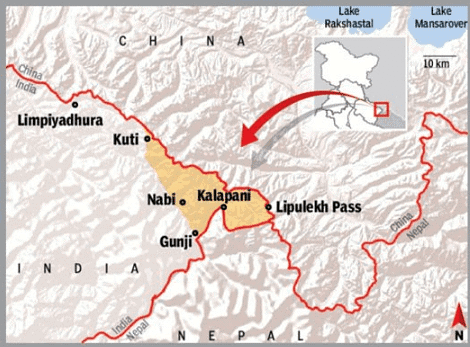 India Nepal
India Nepal
- Kalapani:Kalapani is a valley that is administered by India as a part of the Pithoragarh district of Uttarakhand. It is situated on the Kailash Mansarovar route. The latest political map of India reiterated the Indian claims on the region that Nepal says belongs to its westernmost part. India claims the historic region as part of Uttarakhand.
- The Kali River in the Kalapani region demarcates the border between India and Nepal.
- The Treaty of Sugauli signed by the Kingdom of Nepal and British India (after the Anglo-Nepalese War) in 1816 located the Kali River as Nepal’s western boundary with India. The discrepancy in locating the source of the river led to boundary disputes between India and Nepal, with each country producing maps supporting their own claims.
- Susta: Susta area is one of the disputed territories between India (Uttar Pradesh) and Nepal.
- Susta is located on the bank of the Gandak river (called Narayani river in Nepal).
- The change of course by the Gandak river is the main reason for disputes in the Susta area.
- According to the Sugauli Treaty signed between British East India Company and Nepal in 1816, the Gandak river is the international boundary and eastern part of the river belongs to India and western part of the river belongs to Nepal. At the time the treaty was signed Susta village was situated west of the river. But, over the years, the Gandak river changed its course and Susta moved to the east side of the river, that is now on the Indian side of the river.
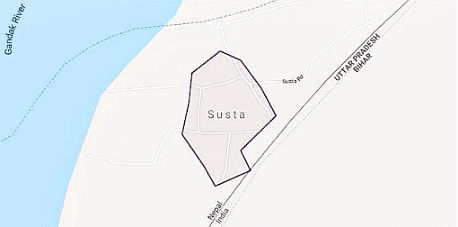 Susta Region
Susta Region
The India-Bhutan Boundary
- Quite peaceful border and there is no boundary dispute between the two countries.
 India-Bhutan
India-Bhutan
The Indo-Pakistan Boundary
- The Indo-Pakistan boundary is the result of the partition of the country in 1947 under the Radcliffe award of which Sir Cyril Radcliffe was the chairman.
- Jammu and Kashmir, Sir Creek are the major disputed regions.
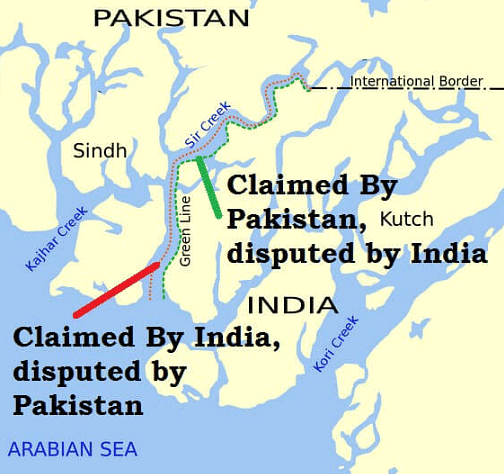 Sir Creek
Sir Creek
Disputed Territories
- Jammu and Kashmir, Pakistan-occupied Kashmir and Gilgit-Baltistan: Pakistan is in the illegal and forcible occupation of approximately 78,000 sq. km of Indian Territory in Jammu and Kashmir. In addition, under the so-called Sino-Pakistan Boundary Agreement of 1963, Pakistan illegally ceded 5,180 sq. km in Pakistan Occupied Kashmir to China.
- Siachen Glacier: The Siachen Glacier is located in the eastern Karakorams in the Himalayas just east of the Actual Ground Position Line between India-Pakistan.
- The entire Siachen Glacier, with all major passes, is currently under the administration of India since 1984 (Operation Meghdoot).
- Saltoro Ridge:The Saltoro Mountains mountain range is a subrange of the Karakoram Heights or of Saltoro Ridge. They are located in the heart of the Karakoram, on the southwest side of the Siachen Glacier.
- They are claimed as part of Jammu and Kashmir Union Territory by India and as part of Gilgit-Baltistan by Pakistan.
- In 1984, India assumed military control of the main peaks and passes of the range, with Pakistani forces into the glacial valleys just to the west.
- Sir Creek:It is a 96 km long strip of water disputed between India and Pakistan in the Rann of Kutch marshlands.
- Pakistan claims the line to follow the eastern shore of the estuary while India claims a centerline (differing interpretations of paragraphs 9 and 10 of the Bombay Government Resolution of 1914 signed between the then Government of Sindh and Rao Maharaj of Kutch).
- The International Boundary in the Sir Creek area and International Maritime Boundary line (IMBL) between India and Pakistan have not been demarcated.
The India-Bangladesh Border
- India’s 4,096 km long border with Bangladesh is the longest.
- This boundary has been determined under the Radcliffe Award which divided the erstwhile province of Bengal into two parts.
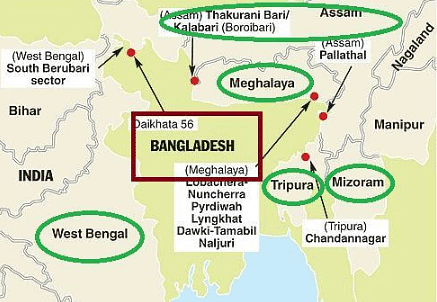 Indo-Bangladesh
Indo-Bangladesh
 New Boundaries on Ind-Ban border
New Boundaries on Ind-Ban border
India-Myanmar Boundary
- This boundary runs roughly along the watershed between the Brahmaputra and Ayeyarwady [Irrawaddy].
- It passes through thickly forested regions, with Mizo Hills, Manipur, and Nagaland on the Indian side and Chin Hills, Naga Hills, and Kachin state on the Myanmar side.

India-Sri Lanka Boundary
- India and Sri Lanka are separated from each other by a narrow and shallow sea called Palk Strait.
- Dhanushkodi on the Tamil Nadu coast in India is only 32 km away from Talaimanar in the Jaffna peninsulain Sri Lanka. These two points are joined by a group of islets forming Adam’s Bridge.
- Though, by and large, peace has reigned where the Indo-Sri Lanka border issue is concerned, there were tensions over the question of who owned Kachchatheevu Island in the Palk Strait. It was given by India to Sri Lanka in 1974.
 India-Sri Lanka Border
India-Sri Lanka Border
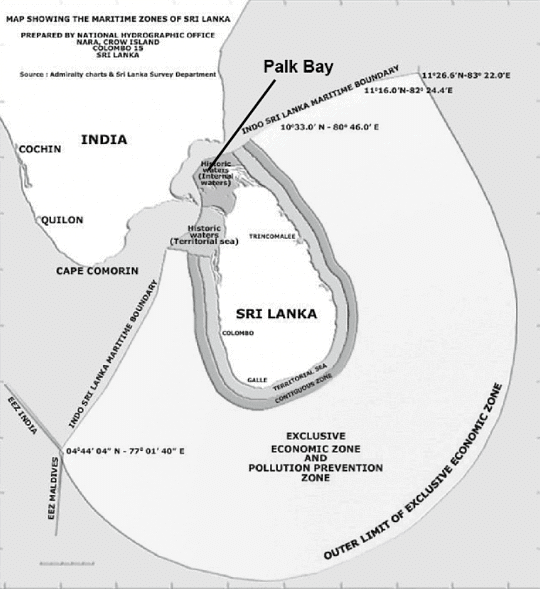 Maritime Region IND-SL
Maritime Region IND-SL
Do you Know
The Equator, an imaginary line that circles the Earth and divides it into the Northern and Southern Hemispheres, traverses a total of 13 nations. These countries include Ecuador, Colombia, and Brazil in South America; Sao Tome & Principe, Gabon, the Republic of the Congo, the Democratic Republic of the Congo, Uganda, Kenya, and Somalia in Africa; and Maldives, Indonesia, and Kiribati in Asia-Pacific.
Conclusion
In conclusion, India's vast geographical extent and diverse climate are shaped by its unique position in the northern hemisphere and its varied latitudinal range. The country shares borders with numerous neighboring countries, resulting in a range of territorial disputes and diplomatic challenges. Despite these issues, India maintains strong cultural and economic ties with its neighbors, fostering regional cooperation and stability. The country's rich geographical features, such as its extensive coastline, mountain ranges, and diverse climate, contribute to its distinct identity and play a crucial role in its development and progress.
|
303 videos|636 docs|252 tests
|
FAQs on Space Relationship of India with Neighbouring Countries - Geography Optional for UPSC
| 1. What are the key features of the Eastern Coastal Plains of India? |  |
| 2. How does India’s geographical extent influence its relationships with neighboring countries? |  |
| 3. What are the major rivers that flow through the Eastern Coastal Plains? |  |
| 4. What is the significance of the Eastern Coastal Plains in terms of economic activities? |  |
| 5. How do climatic conditions in the Eastern Coastal Plains affect the region? |  |





















